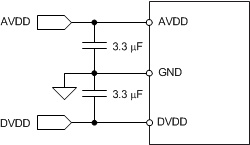JAJSCL4 November 2016 ADS7049-Q1
PRODUCTION DATA.
10 Power Supply Recommendations
10.1 AVDD and DVDD Supply Recommendations
The ADS7049-Q1 has two separate power supplies: AVDD and DVDD. The device operates on AVDD; DVDD is used for the interface circuits. AVDD and DVDD can be independently set to any value within the permissible ranges. The AVDD supply also defines the full-scale input range of the device. Always set the AVDD supply to be greater than or equal to the maximum input signal to avoid saturation of codes. Decouple the AVDD and DVDD pins individually with 3.3-µF ceramic decoupling capacitors, as shown in Figure 43.
 Figure 43. Power-Supply Decoupling
Figure 43. Power-Supply Decoupling
10.2 Estimating Digital Power Consumption
The current consumption from the DVDD supply depends on the DVDD voltage, load capacitance on the SDO line, and the output code. The load capacitance on the SDO line is charged by the current from the SDO pin on every rising edge of the data output and is discharged on every falling edge of the data output. The current consumed by the device from the DVDD supply can be calculated by Equation 3:
where
- C = Load capacitance on the SDO line
- V = DVDD supply voltage and
- f = Number of transitions on the SDO output
The number of transitions on the SDO output depends on the output code, and thus changes with the analog input. The maximum value of f occurs when data output on SDO change at every SCLK. SDO data changing at every SCLK results in an output code of AAAh or 555h. For an output code of AAAh or 555h at a 2-MSPS throughput, the frequency of transitions on the SDO output is 12 MHz.
For the current consumption to remain at the lowest possible value, keep the DVDD supply at the lowest permissible value and keep the capacitance on the SDO line as low as possible.
10.3 Optimizing Power Consumed by the Device
- Keep the analog supply voltage (AVDD) as close as possible to the analog input voltage. Set AVDD to be greater than or equal to the analog input voltage of the device.
- Keep the digital supply voltage (DVDD) at the lowest permissible value.
- Reduce the load capacitance on the SDO output.
- Run the device at the optimum throughput. Power consumption reduces with throughput.